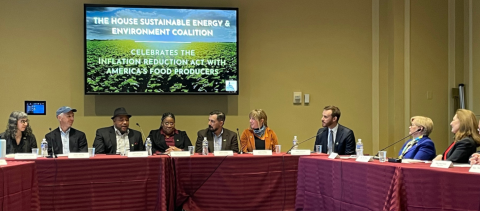SEEC Celebrates America’s Food Producers Implementing Climate-Smart Conservation

Washington, D.C. – Today, the House Sustainable Energy and Environment Coalition (SEEC) — through the leadership of the SEEC Climate and Agriculture Task Force — hosted a public roundtable with farmers from red and blue states who are working to secure a climate-resilient food supply chain for Americans across the nation. Empowered with the $19.5 billion in Inflation Reduction Act (IRA) investments for the U.S. Department of Agriculture’s (USDA) climate-smart programs, our farmers, foresters, and ranchers are playing a pivotal role in the fight against the climate crisis that will benefit generations to come.
The event livestream can be found here.
“During a time when farmers are facing a torrent of climate related disasters, federal support for our producers is needed more than ever,” said SEEC Climate and Agriculture Task Force Co-Chair Rep. Chellie Pingree (ME-01). “By giving our farmers the resources to adapt and mitigate climate change and expanding oversubscribed programs like the Environmental Quality Incentives Program and the Conservation Stewardship Program, the conservation funding secured by Congressional Democrats and President Biden in the Inflation Reduction Act is a win for our farmers and for our planet. That’s why as a longtime farmer and member of the House Agriculture Committee, I am fighting to protect these historic investments in the upcoming Farm Bill.”
“Many of our farmers have already developed creative ideas about how to sequester carbon or reduce emissions to slow down the effects of climate change," said SEEC Climate and Agriculture Task Force Co-Chair Rep. Kim Schrier (WA-08). "As we work on the 2024 Farm Bill, I want to ensure that farmers have a seat at the table, especially when we are talking about climate solutions. Congress must continue to support their efforts by fighting to protect the nearly $20 billion in conservation funds the Inflation Reduction Act offers."
“Up home on our farm in the Ozarks, we work to both preserve and restore the health of our natural systems primarily through rotational grazing,” said Jared and Lindi Philips (Branch Mountain Farm; Lincoln, Arkansas). “Though many consumers are renegotiating their relationship with food, our local markets do not always support prices that reflect the real costs of farming with conservation in mind. Government programs, such as USDA’s Environmental Quality Incentives Program, that support conservation agriculture allow us to farm based on more than just our bottom line.”
“Legacy Taste of the Garden is working with the USDA’s Natural Resources Conservation Service to put up a demonstration farm showing conservation practices so that people can actually see and understand how to apply and be a part of the programs,” said Denise and John Jamerson (Legacy Taste of the Garden; Princeton, Indiana). “Having access to these programs and knowledge is going to be important to the viability and sustainability of the farms of the future. To protect our land is to protect our future and our children."
"Organic farms and ranches - and all real organic producers - have conservation and soil health at their core and have been sustainable, regenerative and "climate smart" since long before those labels became popular,” said Pryor Garnett (Garnetts Red Prairie Farm; Sheridan, Oregon). “Our farm benefited greatly in its early years from the Natural Resources Conservation Service’s Organic Environmental Quality Incentives Program funding to help us trial, and then implement, conservation practices to reduce tillage, develop viable crop rotations, effectively use cover crops and support pollinators, to name just a few. Those practices help sequester greenhouse gases, build soil fertility and improve biodiversity. They enhance our farm's ability to produce high quality, certified organic grain and other food, feed and seed for local folks, and thereby increase our regional food system's resilience to climate change and supply chain disruptions.”
“As a small-scale farmer, climate change is one of the biggest threats to my operation, and one of the most important challenges to address through my farming practices,” said Ariana Taylor-Stanley (Here We Are Farm; Trumansburg, New York). “USDA conservation programs have been a critical tool in enabling me to pay my crew to help with projects - like planting trees - that don’t pay for themselves in one season. I’m so glad that Inflation Reduction Act funding is enabling more farmers to access conservation programs to address climate change and I hope the next Farm Bill will continue to expand this support to farmers who have been left out of it.”
“The Inflation Reduction Act's generational investments support the livelihoods of countless farmers - in red and blue states alike - by building climate resilience,” said Mike Lavender (Policy Director, National Sustainable Agriculture Coalition). “Farmer demand for these climate-focused investments has to date far outpaced funding availability, and it's clear that these IRA funds actually make more money available to all farmers and for all conservation activities. For the prosperity of our farmers, communities, and food system, it's essential that Congress fully protect these funds in the ongoing farm bill reauthorization."